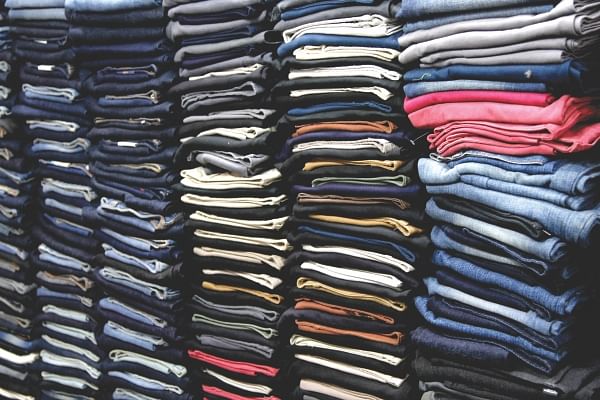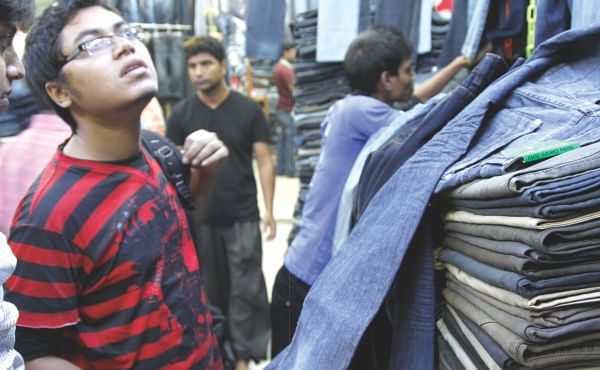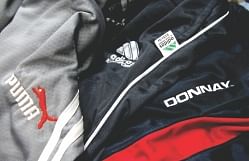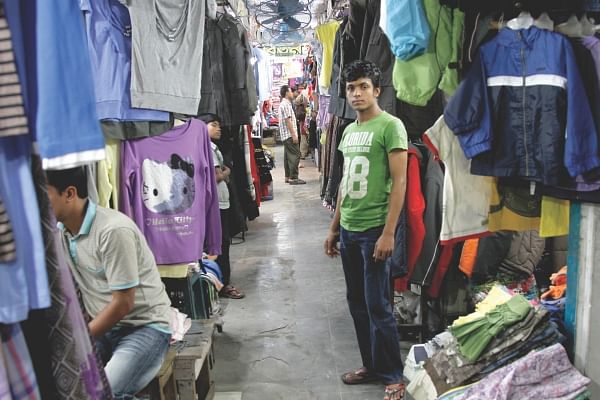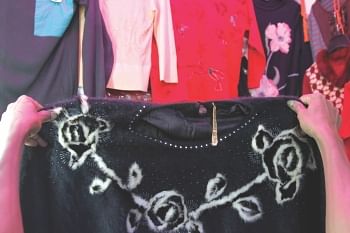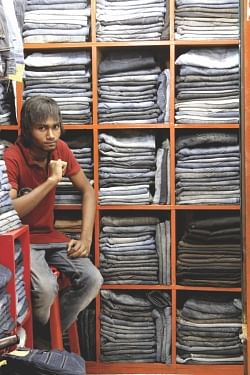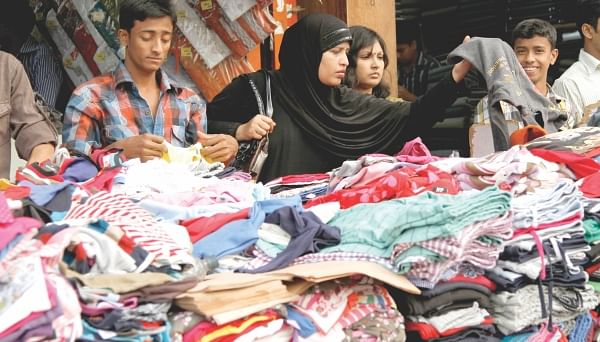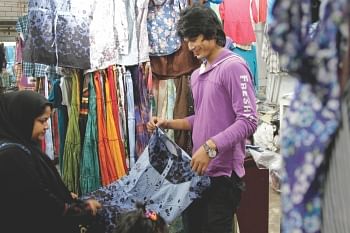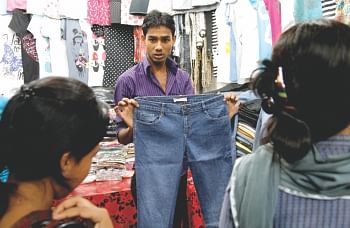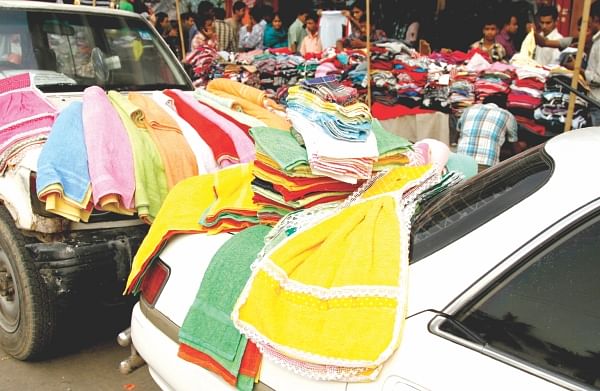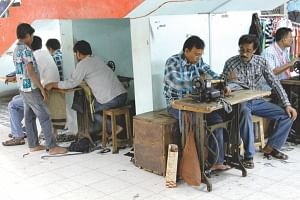| Home - Back Issues - The Team - Contact Us |
 |
| Volume 10 |Issue 43 | November 18, 2011 | |
|
|
Cover Story
Rejected Treasures ANIKA HOSSAIN Photos: Amirul Rajiv Fashion is an ever-evolving concept, which makes being fashionable a full time job that keeps you on your toes. One minute you're hunting through your mother's old wardrobe looking for her old bell bottoms (that were oh so trendy when she was in high school and are back in style now) but before you even have time to lose weight to fit into them, the models in your favourite magazine are posing in skinny jeans (that look more like thermal underwear than actual trousers)—but it's Vogue so you don't argue, you go out there and you find yourself one– and no matter what it takes, you fit into them- even if they give you chicken legs.
The same rules apply for traditional wear, and fortunately, in our country, a large selection of materials for shalwar kameezes can be purchased at bargain prices in many stores. But fashion in Bangladesh has evolved dramatically over the recent years, and many youngsters have now expanded their horizons to western wear. Men have worn western clothing since colonial times, but the women have made an interesting journey starting at saris, slowly making their way through kameezes, then fatuas with jeans (not without a scarf of course) and finally discovering t-shirts, tank tops, shirts, capris, a variety of skirts and even dresses. It is not uncommon to see teenagers in western outfits, walking confidently around town, or a working woman in her twenties, stylishly dressed in formal trousers. While the demand for these clothes have increased, it is unfortunate that a satisfactory supply is not readily available at our endless number of malls yet.
“There are stores like Westecs, Yellow and Pride, which now has a new line called Urban Truth,” says Tasneem Hossain, a teenager in search of the perfect graphic tee, “But their clothes are really expensive and people my age can't always afford to buy a top for TK 1200! My monthly pocket money is less than that!” Another forlorn teenager, Ashna Rahman says, “Most of my clothes are from abroad. I get them when I go on holiday with my parents to the US or Thailand or the UK, and it's hard to keep up with the changing trends here.” But not everyone can afford to go shopping abroad. So where does a person, looking for the latest, perhaps even branded western wear, at reasonable prices, shop? Any savvy Dhakaite will point you towards two main locations—the famous Bongo Bazaar and the newly renowned Doja Market, otherwise known as the shopper's paradise. Located near Gulistan and opposite of Dhaka College respectively, these markets are the shopper's haven for export quality western wear at dirt-cheap prices. Garments industries from all over the country sell their surplus products here, and customers, both local and foreign, swarm to these places to grab up the best buys.
At first glance, these markets don't exactly look like desirable places to go to, for a relaxing day of shopping. A far cry from the usual upscale shopping malls, these places, with their dim lighting, tiny stores overflowing with clothes, dirty floors, suffocating smells and the shop keepers whistling the latest Bengali dance numbers as you walk by, are still treasure troves for amazing finds. “The first time I went to Doja market, I thought I would pass out from the heat and the smells,” says Auroni Islam, working for an advertising agency “But my friends encouraged me to sift through the piles of clothes and I found my first Versace trousers there! For TK 200! I couldn't believe my eyes. I had seen a similar pair in Elle magazine and it costs $175 if you buy it from an actual Versace outlet so you can imagine how thrilled I was.”
Versace is just one of the few brand named products you will find here. “We sell export quality products made for ZARA, H&M, GAP and Mango at out store,” says Kader Mia, a shopkeeper at Doja Market, “Our products arrive from factories in Gazipur and Mirpur mostly, and prices range from TK 100 to TK 500, depending on the condition of the clothes.” As you walk through the narrow alleys, you will come across every kind of clothing store imaginable, catering to the needs of men and women, the elderly and children, the fashionable and the comfort seekers. There are some stores selling denim products of all kinds, ranging from trendy jeans to denim jackets, skirts and dresses, while others offer winter jackets, sweaters, scarves and gloves. Some have the latest designer dresses, while others have the Victoria’s Secret lingerie you've only seen on television and never hoped to find in this country. What is interesting about these markets is how they manage to obtain such a diverse assortment of the latest fashions. According to Nurul Abrar, the director of Evedress Shirts Ashulia, the process is a complex, somewhat shady one. “At my factory, we make shirts for companies like Benetton, Russell, Karma etc,” says Abrar, “We generate two kinds of rejects. One, the stock load from cancelled orders mostly due to delayed shipments, and two, the excess shirts we produce in case of defects. We usually make five percent more than the original order. The excess is bought by certain local people, at very low rates and they in turn will supply them to buyers from Bongo Bazaar and Doja market.”
While it would be profitable for Abrar to supply to these markets directly, this is not possible. “Even if I would like to, there are local politics involved which would prevent me from doing so,” says Abrar, “There are people, who will bribe the factory workers to cause trouble if I try to take away the income they make from our surplus.” Even if the garment business owners found a way around such local politics, there are other factors, which prevent them from supplying locally. According to Tamzeed Hamid (not his real name), whose factories make clothing for labels like ZARA, Benetton, H&M (Sweden), HBC (Canada), Bershka (Spain) etc, his company policy prohibits him from supplying his products locally. “We have a clause in the contracts with our clients, which clearly states that we much destroy all the leftover items from the original order,” says Hamid. “We usually have four to five percent excess and in our factory, we burn them. There are many factories which deal with middlemen and supply these items locally, but whether this is legal, I cannot say.” Iqbal Hossain, who is also in the garment business says, “Often, because some of our products fail the chemical test they are required to take before they can be exported,” says Hossain, “Or if production is delayed, we sell off the excess clothing to local middlemen. Some of our clients require us to destroy these products, some don't and we sell those that we are allowed to. The amount of surplus is not very significant so we probably won't make much of a profit by supplying them to the local markets ourselves, but then there is also the issue of keeping certain people happy so our business can run smoothly. So you can say, we let the local middlemen buy the leftovers as an act of goodwill.” Contrary to popular belief, Doja and Bongo don't just sell defective rejects from garment factories. “We have two types of products here,” says Mohammad Reaz Ahmed, a shopkeeper at Bongo Bazaar, “Export quality products from garment factories and clothes we produce ourselves at our factory in Keraniganj. The export products are not always defective. Sometimes a shipment gets cancelled or an excess amount of clothing is made and these come to us in mint condition. We sell these at a higher price than the defective ones,” he says.
“What I find most convenient about Doja and Bongo Bazaar is that not only do they have great clothes at cheap prices, if the clothes don't fit, they have tailors sitting on the upper levels of the market who will alter them for you within minutes,” says Siam Habib, a student looking for Lee jeans. This service is also available for a very small sum. “We charge TK 30 for altering shirts and TK 100 for trousers. We also alter larger sizes for various stores in this market, to fit the average Bangladeshi,” says tailor Mithu (not his real name). Mithu and his colleagues have set up shop on the third floor of Bongo Bazaar. If you climb up the steep, rather daunting staircase, you will find him sitting in the middle of a large pile of clothing with his tiny sewing machine. Some stores only sell products made for the local market. “We use materials purchased from Narayanganj that have been leftover from garment factories,” says Abu Sharif, another shopkeeper at Bongo Bazaar. “These are imported materials, but we use them to make clothes for the local market at our factory in Dhaka. The designs are copied from the products being exported, and are made for young customers, in their teens and twenties.” Other stores only stock export quality products but cater to a range of clientele. “All our products were made for Levi's, Dockers, Lee, and North Face,” says Saquibul Hasan Kamil, “Our customers are mostly youngsters and parents buying clothes for their little ones, but most of our stock is bought up by foreign buyers or businessmen, from Nepal, Bhutan, Pakistan and the Middle East. They buy in bulk at cheap prices and set up their own show rooms abroad.” Business with these foreign buyers is so profitable, some store owners like Mohammad Manik Hossain who has set up store at the Doja Market, mainly cater to their needs. “We get products which were made for G-Star, E-Spirit, Nike, Reebok, Hugo Boss, Marks & Spencer, Calvin Klein and many other good companies,” he says, “And while selling to the local customers helps us break even, our most profitable deals are made with foreign buyers from Nepal, Bhutan and India to whom we sell in bulk.”
A walk around Bongo Bazaar can also help you dig up those rare stores that sell second hand clothes, which have been shipped from Europe, the US, Australia, Japan, China- you name it. These clothes are in perfect condition, worn perhaps once or twice at most, but more importantly, some of these clothes bear tags of the most exclusive and coveted brands in the world. Emdad, the storekeeper of one of these special stores is selling branded goods from Dolce & Gabbana, Prada, Christian Dior, Gucci and Versace. “Most of these clothes are as good as new when they arrive, but if they do need repair, we make the necessary arrangements,” says Emdad, “Clothes from these brands are not made in Bangladesh, so customers who recognise and appreciate them, flock to my store. We recently received some Angora sweaters for women, made from the finest wool. These would cost upto $100 in an outlet abroad, but we have priced them at TK1000 here. We get all kinds of clothes here, from ski wear, to Japanese kimonos.” Alongside these stores carrying authentic brands, there are those that will sew logos of well known brands on low quality products and try to pass them off as original North Face jackets and Dockers pants. “We make these products ourselves,” says Mohammad Jewel, a storekeeper at Bongo, “We stitch the logos on because our customers like these brands. We don't lie to them if they ask if these are original export quality products.” So the next time you're in Bongo, make sure you do the asking first. Although more people have started wearing western clothes and learning about foreign brands fairly recently, business in these markets has been flourishing since the 70s. This is mostly because of the large collection of winter wear available here. Zafreen Jamil, who is currently enrolled in an American university says, “I never buy winter clothes in America. I always come here and stock up on sweaters and jackets here. I've bought sweaters and warm t-shirts from Ralph Lauren, Adidas, Nike and Puma, and all I brought with me here was TK 2000. I got a lovely winter coat for only TK 500, if I bought it from JC Penny's, it would be $200 at least.”
Lately, however, according to many salesmen, business has been suffering. “This could be because the economy is suffering, and many people can't afford to shop as much anymore,” says Rezaul Islam, the caretaker of a store in Doja. “The rich are getting richer, so they probably think buying rejects from garment factories is beneath them. All I know is, last year the sales were much higher during Eid and winter, but this year, we haven't sold as much.” Islam's neighbouring shopkeeper, Naser Ali, has the same complaints. “Our stores are not as nicely set up as those in large shopping malls, and this is perhaps the main reason people don't want to come here much anymore,” he says. “The prices of products have gone up, and we have to pay a higher amount for each item. Customers don't understand that. The pair of jeans I used to buy for TK 100 now costs me TK 200, but the customers refuse to pay the higher price. How am I supposed to make a profit like that? I have to pay TK 15000 for my store which is only 160 square feet, so you can imagine how difficult it is for us to do business this way.”
Interestingly enough, some astute shop owners have found a way around that. They simply carry their wares with them, and set up shop wherever they find a parked car, motorbike, cycle, rickshaw and even the random thela gari (go cart). “This saves rent and utility costs, which are sky high these days,” smiles Billal Hossain, as he conducts business from the bonnet of a parked jeep. “I always make a profit and my store is the first the customers see when they swing by the market.” Despite their troubles, most salesmen report that they run a fairly steady business year round. The tiny shops, buzzing with people, the sounds of haggling, the friendly banter between shopkeepers and their loyal regular customers is proof of that. Those who avoid these markets because of the ambience are definitely missing out, because at the end of a day at one of these places, you may not have had a relaxing day of shopping, but you will go home with a sense of accomplishment, carrying more bags than you can manage, having found exactly what you were looking for, at prices you never imagined possible, with your wallets still full (okay maybe half full), to add to your now up-to-date, trendy wardrobe.
Copyright (R) thedailystar.net 2011 |
|||||||||||
